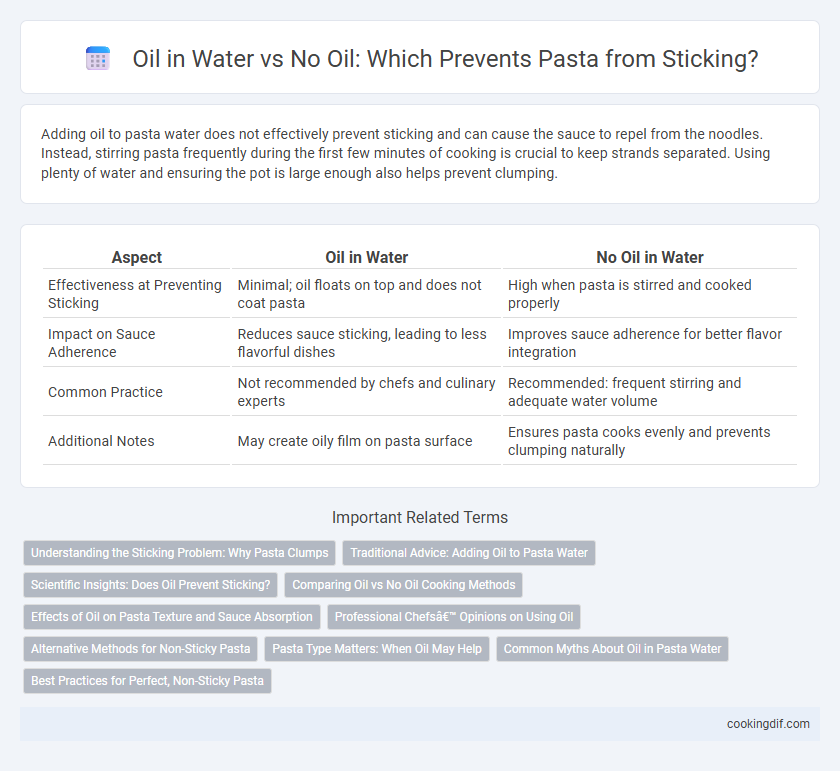Adding oil to pasta water does not effectively prevent sticking and can cause the sauce to repel from the noodles. Instead, stirring pasta frequently during the first few minutes of cooking is crucial to keep strands separated. Using plenty of water and ensuring the pot is large enough also helps prevent clumping.
Table of Comparison
| Aspect | Oil in Water | No Oil in Water |
|---|---|---|
| Effectiveness at Preventing Sticking | Minimal; oil floats on top and does not coat pasta | High when pasta is stirred and cooked properly |
| Impact on Sauce Adherence | Reduces sauce sticking, leading to less flavorful dishes | Improves sauce adherence for better flavor integration |
| Common Practice | Not recommended by chefs and culinary experts | Recommended: frequent stirring and adequate water volume |
| Additional Notes | May create oily film on pasta surface | Ensures pasta cooks evenly and prevents clumping naturally |
Understanding the Sticking Problem: Why Pasta Clumps
Pasta clumps mainly due to the release of starches when boiling, which creates a sticky surface causing strands to adhere to each other. Adding oil to the water can coat the pasta, but it often floats on top and doesn't prevent sticking effectively since starch remains the primary factor. Stirring frequently during the initial cooking phase is a more reliable method to prevent pasta from clumping by dispersing starches and keeping noodles separate.
Traditional Advice: Adding Oil to Pasta Water
Adding oil to pasta water is a traditional practice aimed at preventing noodles from sticking together during cooking. However, scientific tests reveal that oil tends to float on the surface and does not effectively coat the pasta, reducing its impact on stickiness. Instead, stirring pasta frequently and using enough water are more effective methods to prevent clumping and ensure even cooking.
Scientific Insights: Does Oil Prevent Sticking?
Scientific studies indicate that adding oil to pasta cooking water does not effectively prevent sticking; instead, it creates a thin oil layer on the surface that repels sauce and does not stop pasta grains from adhering. The primary factor in preventing pasta from sticking is sufficient boiling water agitation and adequate water volume to allow free movement. Research shows that proper stirring and using ample water minimize starch release concentration, which is the key contributor to pasta sticking during cooking.
Comparing Oil vs No Oil Cooking Methods
Adding oil to pasta water slightly reduces foaming but does not prevent sticking effectively; pasta sticks mainly due to starch released during cooking. Cooking pasta without oil and stirring frequently prevents clumping better, as oil can coat pasta and cause sauce to slide off. Most chefs recommend skipping oil in favor of ample water and regular stirring for optimal texture and sauce adherence.
Effects of Oil on Pasta Texture and Sauce Absorption
Adding oil to pasta water can create a slippery surface on the pasta, reducing stickiness but also inhibiting sauce absorption, resulting in a less flavorful dish. Without oil, pasta tends to release more starch into the water, allowing sauces to cling better and enhance texture and taste. The key to preventing sticking while maintaining optimal texture is stirring the pasta frequently and using ample water instead of relying on oil.
Professional Chefs’ Opinions on Using Oil
Professional chefs widely agree that adding oil to pasta cooking water is unnecessary and can hinder sauce adhesion by creating a slippery surface on the noodles. Instead, chefs recommend stirring pasta frequently during boiling to prevent sticking and ensuring the water is at a rolling boil before adding pasta, which promotes even cooking and separation. Many culinary experts emphasize that reserving pasta water, rich in starch, is essential for achieving a perfect sauce consistency rather than relying on oil in the water.
Alternative Methods for Non-Sticky Pasta
To prevent pasta from sticking without using oil in water, stirring frequently during the first few minutes of cooking is essential. Using a large pot with ample water allows pasta to move freely, reducing clumping. Adding salt not only enhances flavor but also helps maintain the pasta's firmness and prevents sticking.
Pasta Type Matters: When Oil May Help
Adding oil to boiling water can prevent stickiness for starchy pasta types like fresh egg noodles and homemade varieties, which tend to release more starch during cooking. For denser pasta such as durum wheat semolina-based shapes or whole grain pasta, oil is generally unnecessary due to their lower starch content. Using oil selectively based on pasta type helps maintain optimal texture and prevents unwanted clumping.
Common Myths About Oil in Pasta Water
Adding oil to pasta water is a common myth believed to prevent sticking, but it actually creates a slippery surface that keeps sauce from adhering properly. Pasta sticks primarily because of inadequate water quantity or insufficient stirring during the initial cooking phase. Using plenty of water and stirring occasionally is a more effective method than oil for preventing pasta from clumping together.
Best Practices for Perfect, Non-Sticky Pasta
Adding oil to pasta water is not recommended for preventing sticking, as it creates a slippery layer that hinders sauce adherence. The best practice involves using plenty of boiling water and stirring pasta frequently during the first few minutes of cooking to prevent clumping. Proper draining and combining pasta immediately with sauce ensures a perfect, non-sticky texture.
Oil in water vs no oil for preventing sticking Infographic

 cookingdif.com
cookingdif.com